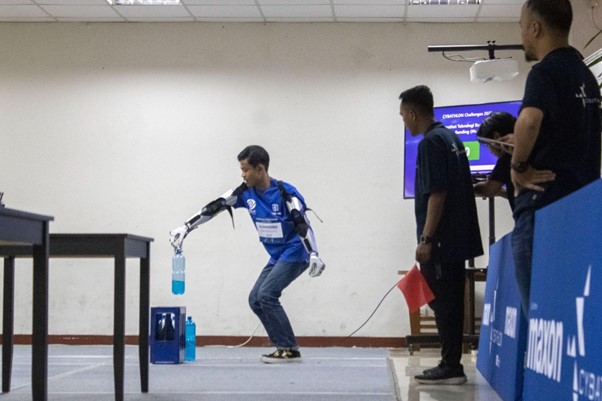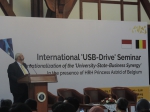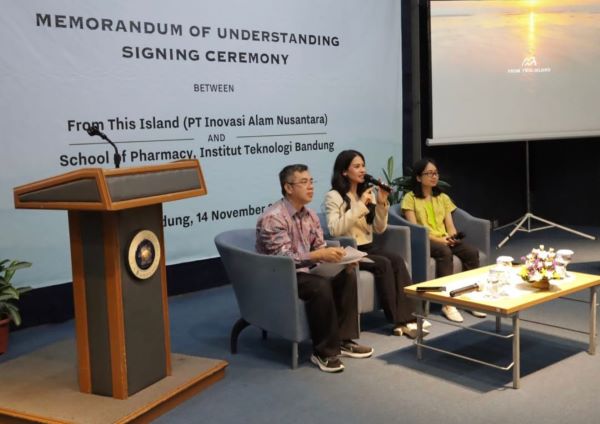Development of Bioindicator for Management of River Water Quality
By Adi Permana
Editor Adi Permana

*Photo by: E-Learning ITB
BANDUNG, itb.ac.id – According to 2016 data by Statistics Indonesia, 56 percent of rivers in Indonesia are heavily polluted. This high level of pollution, especially in Indonesia, to water bodies is caused by human activities and may affect human life and inflict loss.
In the scientific speech titled “Development of Bioindicator as an Effort to Manage River Water Quality”, Prof. Barti said that surface water quality assessment using chemical-physical parameters is not effective in providing protection and control over the ecosystem of water bodies. Therefore in general, the parameter only depicts the quality of water during sampling and does not reflect the real condition. “Hence we need indicators situated at the location of polluted water. The indicator is an organism that becomes one of parameters to determine the condition of water bodies,” she said.
Macrozoobenthos as Bioindicator for Assessment to Surface Water Quality
A macrozoobenthos are microinvertebrates that live attached on riverbed, between rocks, on organic collapses, wooden branches, and other ecosystems near river water. The example of macrozoobenthos are Annelida sp., Sulcospira sp., and Rhyacophilia sp. “These organisms in general have the ability to dissolve big materials into small ones. Those small particles become substrates for bacteria to multiply. This decomposition plays an important role especially in the regeneration of nutrients that support sustainability of river ecosystem,” said Prof. Barti.
Macrozoobenthos as Bioindicators offer several advantages; it reflects the local condition of a river ecosystem, it has a relatively longer life cycle (more than one year), it is easier for sampling, it has various sensitivity toward various pollutants, and it is abundant.
Prof. Barti said that there are three classifications of macrozoobenthos as bioindicators. For mild water pollution, Sulcospira sp. and Rhyacophilia sp. are used due to their low tolerance. For moderate water pollution, Hydrospyche sp. is used due to its moderate tolerance. For heavy water pollution, Chironomus sp. and Tubifex sp. are used due to their high tolerance.
Prof. Barti said that the usage of bioindicator as indicator of river water pollution are done simultaneously with test on water quality analysis using Family Biotic Index (FBI), Lyncoln Quality Index (LQI) and Shannon Wiener index to analytically confirm environmental pollution.
Macrozoobenthos Growth Model
Modeling to the growth of macrozoobenthos is done as a model that predicts the influence of environment on the dynamics of macrozoobenthos population. Prof. Barti said that, by using polynomial repression analysis, it is found that the growth of macrozoobenthos population in every m3 within a particular time is affected by macrozoobenthos growth rate, the total population every one m3, environmental factors, and carrying capacity of macrozoobenthos population.
“The model was tested at Upstream Citarum River and it was found that macrozoobenthos population growth is influenced by abundance of bioindicators, intrinsic growth rate of bioindicators, environmental factors, and environmental carrying capacity,” said Prof. Barti.
Macrozoobenthos as bioindicator can illustrate the effect of harmful substances. In South Africa, biomonitoring program using bioindicator is used as a fast, integrative, and cost-effective approach. “Bioindicator is considered very favorable to see the impact of combination of all contaminants and sources of environmental stress,” she continued.
Bioindicator and its growth modelling can demonstrate ecological condition of waters locally and specifically, as well as can illustrate the integration of the effect of short-term environmental changes. “Macrozoobenthos in Indonesia have a lot of potential to develop and provide convenience to on-field monitoring and enable further monitoring,” she explained.
Reporter: Billy Akbar Prabowo (Metallurgical Engineering 2016)

.jpg)
.jpg)
.png)
.jpg)
.jpg)


